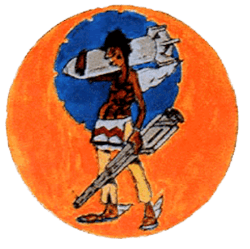788th Bombardment Squadron
| 788th Bombardment Squadron | |
|---|---|
|
Emblem of the 788th Bombardment Squadron | |
| Active | 1943-1946 |
| Country | United States |
| Branch | United States Air Force |
| Type | Bombardment |
The 788th Bombardment Squadron is an inactive United States Army Air Forces unit. It was last assigned to the 467th Bombardment Group at Clovis Army Air Field, New Mexico, where it was inactivated on 4 August 1946.
The squadron was established as a Consolidated B-24 Liberator squadron in 1943. After training in the United States, it moved to the European Theater of Operations the following year. It saw combat until the surrender of Germany in May 1945, earning a French Croix de Guerre with Palm for its actions contributing to the liberation of France. The squadron returned to the United States and began training on Boeing B-29 Superfortresses, but the war ended before the squadron was operational.
History
Established as a B-24 Liberator heavy bombardment squadron in mid-1943 and activated on 1 August. Trained under II Bomber Command in Idaho and Utah. In January 1944 the squadron received deployment orders for the European Theater of Operations (ETO). Moved to RAF Rackheath, Norfolk in England, February–March 1944, and was assigned to the VIII Bomber Command.
Upon arrival in England, was attached to VIII Composite Command and performed special operations missions over Occupied Europe and Nazi Germany, flying black painted aircraft equipped with engine flame dampeners and noise suppression equipment. Engaged in parachuting Allied agents; retrieving others; providing supplies and equipment to Resistance Forces; leaflet dropping and other clandestine missions.
Returned to home unit in August 1944 and engaged in very long range strategic bombardment operations over Occupied Europe and Nazi Germany. In combat, the unit served chiefly as a strategic bombardment organization, attacking the harbor at Kiel, chemical plants at Bonn, textile factories at Stuttgart, power plants at Hamm, steel works at Osnabrück, the aircraft industry at Brunswick, and other objectives.I Attacked German communications and fortifications during the Battle of the Bulge, December 1944 – January 1945. Hit enemy transportation to assist the Allied assault across the Rhine in March 1945.
After the German Capitulation in May 1945, the squadron was ordered back to the United States for B-29 transition and redeployment to the Pacific Theater of Operations (PTO). Redeployed to the US June/July 1945. Upon arrival, most of the group was demobilized due to their combat service in Europe; a cadre of officers and men was formed at Sioux Falls Army Air Field, South Dakota on 25 August.
At Sioux Falls, the unit was reformed with newly trained pilots, aircrews and ground personnel. The reformed group was sent to Harvard Army Airfield, Nebraska for initial Second Air Force training. The Japanese Capitulation in early August canceled the planned deployment to the Pacific, however the group continued to train
Due to the advanced training state of the squadron received new B-29 Superfortresses and completed training. In December 1945 was assigned to a permanent base at Clovis Army Air Field, New Mexico as part of Continental Air Forces. The unit, however was inactivated on 4 August 1946 due to personnel shortages and funding reductions in the immediate postwar Air Force. The equipment and remaining personnel were reassigned to other SAC units.
Lineage
- Constituted 788th Bombardment Squadron (Heavy) on 19 May 1943
- Activated on 1 Aug 1943
- Redesignated 788th Bombardment Squadron, Heavy c. 10 August 1944
- Redesignated 788th Bombardment Squadron, Very Heavy on 5 August 1945
- Inactivated on 31 March 1946
Assignments
- 467th Bombardment Group, 1 Aug 1943
- VIII Air Force Composite Command, 11 May 1944
- Attached to 801st Bombardment Group (Provisional)
- 467th Bombardment Group, 10 Aug 1944-4 Aug 1946
Stations
- Wendover Field, Utah, 1 August 1943
- Mountain Home Army Air Field, Idaho, 8 September 1943
- Kearns Army Air Field, Utah 17 October 1943
- Wendover Field, Utah, 2 November 1943 – 12 February 1944
- RAF Rackheath (AAF-145), England, 11 March 1944 – 12 June 1945
- Sioux Falls Army Air Field, South Dakota, 15 July 1945
- Fairmont Army Air Field, Nebraska, 25 July 1945
- Alamogordo Army Air Field, New Mexico, 22 August 1945
- Harvard Army Air Field, Nebraska, 8 September 1945
- Clovis Army Air Field, New Mexico,7 January-4 August 1946
Aircraft
- B-24 Liberator, 1943–1945
- B-17 Flying Fortress, 1945–1946
- B-29 Superfortress, 1946
Notes
References
- Maurer, Maurer, ed. (1982) [1969]. Combat Squadrons of the Air Force, World War II (PDF) (reprint ed.). Washington, DC: Office of Air Force History. ISBN 0-405-12194-6. LCCN 70605402. OCLC 72556.
![]() This article incorporates public domain material from the Air Force Historical Research Agency website http://www.afhra.af.mil/.
This article incorporates public domain material from the Air Force Historical Research Agency website http://www.afhra.af.mil/.


